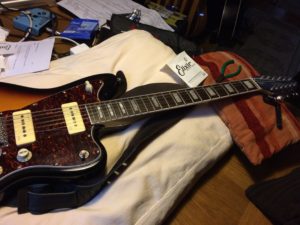I need to re-string my 12-string electric for recording next week with Jez Coad. We’re doing three tracks, and at least one has got 12-string in the guitar guide tracks. They were in fact the original strings from the Revelation factory, and the bass strings had gone pretty dead – so more than overdue.
With twice as many strings, a 12 string guitar is obviously more of a pain to re-string. So much so that as with my acoustics, I buy the expensive but longer-lasting Elixr coated strings – and am very happy with them.
 But the degree of difficulty isn’t just twice that of a normal guitar – more like squaring it than multiplying by two.
But the degree of difficulty isn’t just twice that of a normal guitar – more like squaring it than multiplying by two.
Twelves are usually configured with the top two pairs of strings the same, and the others with one an octave above the norm. The G string therefore has the lightest gauge string as its octave. With the Elixr Lights, it’s a 09.
The order of the octave string is critical too. The usual configuration is for the lowest string to be positioning lowest down, such that a downstroke with the pick plucks the high string first, ensuring the octave and low note ring out in classic 12-string style. You do however develop a style for being able to play just the low note using an up stroke. Rickenbacker 12s however have this the other way round, so that the really clangy octave sound is on the up stroke.
I find the necks of Rickenbacker 12’s too narrow anyway (around half a centimetre less at the nut), which with the space taken up by the extra strings , makes them too cramped for me to play comfortably, hence buying one of the remarkable Revelation RJT60/12’s – at some £1500 less!! (This is well-argued bone of contention – or of defence by Ricky devotees. Each to his or her own!!) But playing the Revelation feels pretty much the same as my other guitars, which is important for me as I switch to the 12 for just a couple of songs.
I do however like the Rickenbacker clang and have been tempted to recut the nut of the Revelation to reverse the string setup. But in fact, it’s all just a question of how you strum; the up-stroke gives you the clang, and the down stroke less so…
But re-stringing a 12 is still a pain. The bridge is a very busy place, and you’ve got to locate each string exactly. Revelation have the normal string positioning up through the body and spring tremolo as with all their guitars, then a second routing for the lower strings through the metal bridge piece itself.
So it’s the usual routine; using a string winder to slacken off one set of strings at a time, cutting off the curl to pull them out at the bridge, then poking the new strings up through the two mounting holes at the bridge. You cut them three pegs longer than the peg they’re destined for – or not at all with strings 3 and 4, then make a half-centimetre right angle so they’ll poke down the hole in the peg. Then holding them in position with a jeweller’s screw driver, winding the winder so they tighten without pinging out.
This is how Revelation string the guitars in their factory. So I replicated this. But next time I’ll do the usual tieing off the strings – as demonstrated here by the legendary Rene Martinez.
You need to be uber careful to locate them correctly at the bridge saddles and nut. And get the gauges the correct way round.
I’d presume that the guitar techs of 12 string guitar stars insist on there being at least one spare 12-stringer. Efficient though a guitar tech like Rene Martinez definitely is (I was fascinated watching him work with John Mayer from backstage at a Wembley gig ), re-stringing a 12 during a gig would be too stressful for me! Just pick up the six and have nice strong chorus setting up your sleeve!

